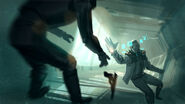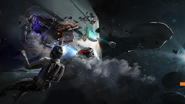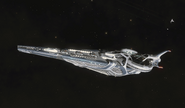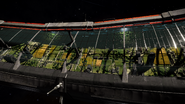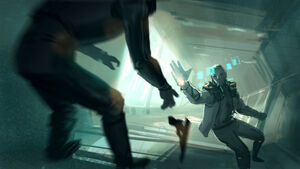
Two Commanders fight in a zero-gravity environment
Gravity in the Elite universe remains a force that cannot be created or nullified on-demand, and anti-gravity or gravity-generation technologies do not exist in any form. Ships, outposts, and installations are traversed by floating, using suit microthrusters, or walking with the aid of magnetic boots, while starports, megaships, and other ships of sufficient size have rotating rings that rely on centripetal force to create artificial gravity.[1] The gravity of stars and planets directly affects how fast ships can travel within a system in Supercruise, with a ship capable of achieving greater speeds the further away it is from any celestial bodies.
Stations[]
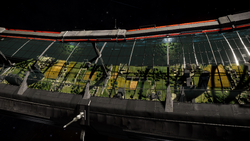
Close up view of the habitat ring of an Orbis station
Starports and Asteroid Bases are large stations comparable to cities floating in space. They rotate slowly to create internal artificial gravity for traders, pilots, tourists and citizens aboard. The rotation maintains the gravity. The free rotation of a station is a lot cheaper than other gravitational options.
The Ocellus and Orbis starports have different habitat rings. The rate of spin produces different levels of artificial gravity. Lower gravity levels are very comfortable for physical work. In the 0.1 g of the docking bay a fit human could lift a one ton mass. Gravity would differ between each tower’s floors. The force of gravity would increase as residents traveled to the station's furthest reaches. This allows starport staff to handle heavy cargo at the station's center with ease. For many residents real daylight would be considered a rare privilege.[2]
Ships[]
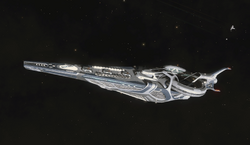
Majestic-Class Interdictor
Ship interiors are generally designed as zero gravity environments. Conventional ships require that pilots, crew, and passengers secure themselves in their seats and cabins in order to safely travel under acceleration while in normal space, but while the ship is not accelerating or is traveling in Supercruise, they can be traversed by floating or, if an individual is wearing a suit, they can walk thanks to tiny electromagnets built into the soles of their shoes and the standardisation of ferromagnetic floors. Some more advanced suits are equipped with microthrusters to aid in movement and provide an edge in zero-g combat.[3]
Some Megaships have rotating habitation rings that use centripetal force to create artificial gravity. The Majestic-Class Interdictor, the main Capital Ship of the Imperial Navy, has an internal rotating ring which provides comfortable artificial gravity for traveling nobles and dignitaries. In contrast, the Federal Navy's Farragut-Class Battle Cruiser is much more utilitarian and sacrifices comfort for durability and firepower.[4]

Experiencing redout in a Hauler (GIF)
While in normal space or during Glide, some ship manoeuvres will subject the pilot to high g-forces. If a pilot experiences high g-forces, their vision will either blacken or redden, which can be used as a warning to ease up. If the pilot experiences a blackout or redout from excessive g-forces, the ship will seize control from the pilot for a short duration, automatically setting itself to zero throttle and stopping any pitch, roll or yaw. This allows the pilot to recover before regaining control of the ship.
Celestial bodies[]
Celestial bodies such as planets and moons have many different strengths of surface gravity depending on their density. Notable gravity-related records include:
- Non-landable Terrestrial Planets:
The highest gravity in which it is possible to walk is 2.69 g, anything over this value disables the Disembark option. Deployment of SRVs has no limit.
Notes[]
- The game allows to land on bodies with very high gravity (the record above). Humans usually faint at about negative 3 g or positive 5 g, depending on condition. Trained fighter pilots in compressed suits (Remlok Suits are a kind of them) can withstand as much as 9 g. U.S. Air Force officer John Stapp demonstrated in a rocket sled that a human can survive 46.2 g without consequences, and he was surpassed by Eli L. Beeding with 82.6 g.[11] But, the highest recorded g-force endured by a human is 214 g during indycar driver Kenny Bräck's race crash.[12] Although, all those lasted for a split-second. It is estimated a human (without a suit) can stay alive at 10 g for one minute, foremost due to a lack of oxyxen. Since the Elite universe has no gravity-altering technology, this constitutes a weak spot in the simulator.
- Places where humans live and work have mostly, even on Earth-like planets, lower gravity than 1 g, which must have a major influence on their bodies. It is rarely mentioned in the lore, except Capitol's "gravity is 40% stronger than on Earth, breeding sturdy people."[13]
Gallery[]
References[]
- ↑ reddit: I am David Braben, co-creator of Elite, creator of Frontier, Frontier II and the upcoming Elite: Dangerous
- ↑ Official The Art of Elite Dangerous art book, August 17 2016
- ↑ Elite Dangerous Newsletter #14
- ↑ YouTube: Elite: Dangerous Progress Diary #6
- ↑ EDSM: Actaea
- ↑ EDSM: KOI 1701 (Via Gravitatis)
- ↑ EDSM: Oresqu B 4 a
- ↑ EDSM: S171 37 8
- ↑ EDSM: Crevit 3 a
- ↑ EDSM: Capella A 6
- ↑ Guinness World Records: Highest g force endured - voluntary
- ↑ Guinness World Records: Highest g force endured - non-voluntary
- ↑ Frontier Forums: Worlds of Elite - Achenar, Beacon of the Empire


